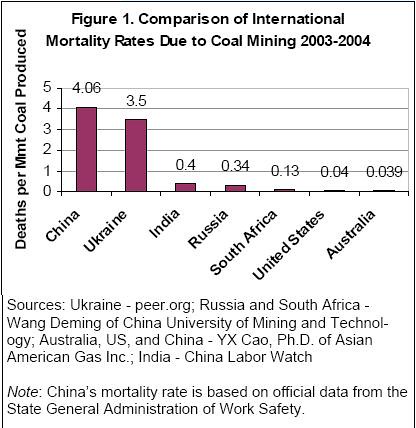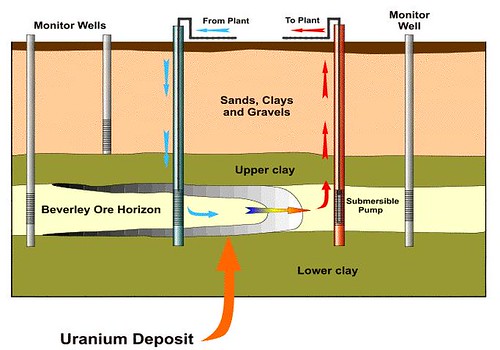The tale of two chinese coal miners who lived. Remember these are the two who lived while 179 others died We also recently had the 12 coal mining deaths in the United States.
The two who lived had to drink their own urine, eat coal and dig through 66 feet of dirt and coal.
How many nuclear energy deaths have there been this year ? Zero.
How about coal mining deaths in the last year ? 5000 to 10,000 worldwide.
How about nuclear energy deaths in the last ten years ? Zero.
How about coal mining deaths in the last ten year ? about 80,000 worldwide.
Many of those who die in coal mines do not die painlessly or instantly.
Many were likely trapped and suffered for days in failed efforts but were too deep to free themselves or for help to reach them in time.
Plus there are the air pollution deaths of about 1 million each year.
Many of those suffered from painful diseases before succumbing.
A lot of deaths and injuries for coal power versus almost none for nuclear power. IT also translates into a lot of human suffering.
For those who only care about animal suffering and deaths, like the Michael Vick and DMX dog fighting, coal kills thousands and millions of animals when mountain tops get blown off to reach coal. Almost the animals and trees in the destroyed forest are killed. There are some that also could be injured and live or injured and die.
So remember the starting point, two chinese miners suffered and struggled for 11 days and lived. Many others suffered and struggled and died.
Even the chemical “scrubbing” of air pollution generates more toxins in the ash
FURTHER READING:
International mine safety

Coal deaths per million tons
2005 coal production
PR China 2226 Mt
USA 951 Mt
India 398 Mt (avg about 150 deaths/year)
Australia 301 Mt
South Africa 240 Mt
Russia 222 Mt
Indonesia 140 Mt
China¹s total death toll from coal mining averages well over 5000 per year – official figures give
5300 in 2000
5670 in 2001
7200 in 2003
6027 in 2004
5,986 deaths in 2005
4,746 deaths in 2006
Ukraine’s coal mine death toll is over two hundred per year
1999: 274
1998: 360
1995: 339
1992: 459
Coal mining in the Ukraine
Coal fatalities by state from 1996 to 2007 from U.S. Department of Labor, Mine Safety and Health Administration.
All mining fatalities by state 1996 to 2007
Fatality stats for mining in the USA
Historical mining deaths and injuries by decade for the USA
[from a surface mining operation]. At mines in the U.S., we find that most fatal accidents on the surface relate to transportation. It could be trucks, front-end loaders, railway cars, belt conveyors, and similar equipment. There are many factors involved in these accidents. Some of the factors are equipment maintenance, roadway design, and training. Another important factor is visibility. In fact, restricted visibility factored into more than a hundred miners’ deaths during a recent 10-year period in the U.S.
Successful evacuation in USA and Australia mines.
Part of the credit for that achievement almost certainly belongs to the Personal Emergency Device. How, you might ask, could the mine operator send a page to everyone under tons and feet of rock?
The key is that the system uses a fluctuating low frequency magnetic field to send messages instead of the electro-magnetic waves. This pager system seems to be a very promising example of new technology that can help to protect miners. Incidentally, it is a fine example of the value of international exchange. This unit was developed and originated in Australia.
So far the examples I have given are of mine safety. The other half of the picture we are concerned with is the occupational health issues. For example, consider a coal miner in Kentucky named Terry Howard. He operated a drill at a surface coal mine. Several years ago, during his prime working years, he developed breathing problems. His illness turned out to be silicosis, contracted from breathing the quartz dust that surrounded him when he drilled into the rock overburden.
Silicosis, as we all know, is an incurable disease and can get worse when the sick person is removed from further exposure. There is no cure for silicosis. Howard became totally disabled. His condition deteriorated rapidly and he died, leaving a widow and three school age children. He was only 45 years old.
In the U.S. we have had health regulations in place to combat lung disease among miners since 1970. There has been great progress but as May mentioned, in 1997 there was still more than 300 new cases of occupational lung disease reported to our agency.
Uranium mining versus coal mining
1. Uranium mining is inherently safer because of differences in mining methods
Uranium mining
Mostly insitu leaching. Putting pipes in the ground and pumping an acid mixture in other pipes and pumps drain the dissolved mixture with uranium in it. No miner goes underground. Open pit surface mining performed at times for both coal and uranium.
Coal mining has a lot more risks for fires and explosions.
Coal mining is for 6 billion tons of coal, uranium mining is for 60,000 tons of uranium each year. 100,000 times less target material. Even the amount of rock removed by uranium mining is less.
Ukraine and China have the highest risks in coal mining and they still send a lot fo guys underground (hundreds of thousands).
The US and Australia (safest coal mines) are highly automated by using long wall mining underground. Guys still die just less because they are 100 times more efficient in terms of manpower.
Mountain top removal for 30% of the coal mines in the USA.
Use 1000 tons of explosives per day to blow away dirt and forest to get at coal. Around 7 billion gallons of sludge gets dammed up. There have been leaks of sludge that have killed all aquatic life in rivers and on one occasion 125 people.
The sludge pond is permitted to hold 2.8 billion gallons of toxic sludge, and is 21 times larger than the pond which killed 125 people in the Buffalo Creek Flood.
Blasting at a mountaintop removal mine expels coal dust and fly-rock into the air, which can then disturb or settle onto private property nearby. This dust contains sulfur compounds, which corrodes structures and tombstones and is a health hazard.

Brian Wang is a Futurist Thought Leader and a popular Science blogger with 1 million readers per month. His blog Nextbigfuture.com is ranked #1 Science News Blog. It covers many disruptive technology and trends including Space, Robotics, Artificial Intelligence, Medicine, Anti-aging Biotechnology, and Nanotechnology.
Known for identifying cutting edge technologies, he is currently a Co-Founder of a startup and fundraiser for high potential early-stage companies. He is the Head of Research for Allocations for deep technology investments and an Angel Investor at Space Angels.
A frequent speaker at corporations, he has been a TEDx speaker, a Singularity University speaker and guest at numerous interviews for radio and podcasts. He is open to public speaking and advising engagements.


Comments are closed.